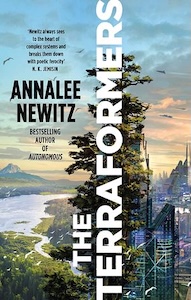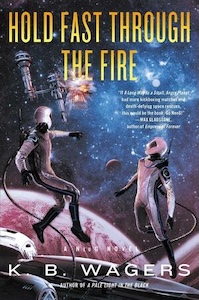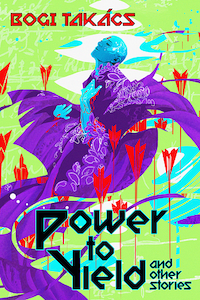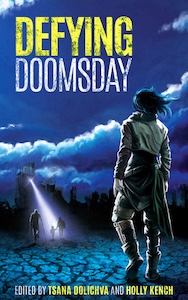“The Ghosts of Trappist” (NeoG Series No. 3) by K. B. Wagers
Ensign Nell “Sapphi” Zika has been working hard to get past her trauma, but the unnerving pleas for help she’s hearing in the Verge and the song she can’t get out of her head are making that increasingly difficult. As Zuma’s Ghost gears up for a final run at the Boarding Games, their expert hacker is feeling anything but confident. Plus, her chief’s robot dog, Doge, is acting weird—a computer problem she can’t find an answer to—and the increasing number of missing freighters is putting everyone living on or stationed around Trappist on edge.
It doesn’t help the NeoG’s mission that Dread Treasure is sidelined from competing in the Boarding Games, and Commander D’Arcy Montaglione is stuck on the front lines of the mystery of the missing ships while also stuck in his own head. Never good at trusting people to begin with, he’s struggling to piece together his new crew in the aftermath of a great betrayal, knowing this may be his final chance at command. The last thing he wants to do is prove his enemies right and end up getting shoved behind a desk and forgotten. The easy answer to missing ships is pirates, but D’Arcy soon realizes the easiest answer is rarely the right one out in the vacuum of space. What’s worse is that the actual pirates are scared of something out beyond the asteroid belt. Something that’s been taking their ships too…
As the unknowns multiply and one of their mysterious enemies escalates by launching an attack on the NeoG itself, the Interceptor crews must brave both cyber and outer space to hunt down their foes, but no one is prepared for the truth that is revealed or the way it will shake the foundations of everything they believe about the universe.
Review
I really enjoyed this book – the characters are great and I love their relationships. That said I occasionally felt like there was too much interpersonal stuff going on instead of focusing on the actual current situation that was happening. Not to a terrible degree since I felt like it made sense to have those elements in it.
Also, while the book is supposed to be set two years after the previous one it doesn’t entirely feel that way with regard to how some characters are dealing with those events. Not that it didn’t make sense in regard to dealing with trauma but it felt a little too much like events had just happened rather than being two years later. As a result the book doesn’t feel like as much of a stand alone story as the author wanted it to be.
In any case I did feel as though the mystery plot was well thought out and I enjoyed how things were handled. There’s a lot of different elements going on within the story and I really enjoyed how the characters figured everything out.
Warnings and additional reviews are available on the StoryGraph page for “The Ghosts of Trappist”.
Book Details

- Author’s Website
- K. B. Wagers
- Publisher / Date
- Harper Voyager, June 2023
- Genre
- Science Fiction
- Page Count
- 538
- Completion Date
- January 3, 2025




